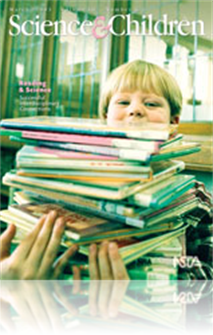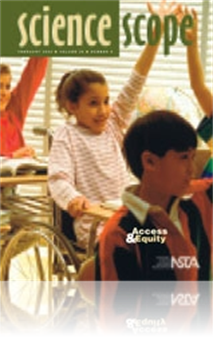All Resources
Journal Article
Careers in Science: An Interview with Forensics Technician Jason Birchfield
This column shares interviews with professionals using science in the workplace. In this month’s issue learn how Jason Birchfield became interested in forensics and how he's a working example of why science is for everyone....
Journal Article
Teaching through Trade Books: Seeing the Seasons
Children’s literature can be a wonderful springboard for classroom learning, motivating students to think scientifically, and helping them develop important science-process skills. The following books: When the Root Children Wake Up and Sky Tree w...
Journal Article
A strong multicultural curriculum and instruction can make significant changes in motivating students in science and mathematics. In an effort to increase participation in science, the authors offer suggestions for making science relevant to all stu...
Journal Article
Computers can be used as a focal point in a course introducing various scientific fields and underscoring the interdisciplinary nature of science. This article presents the objectives, pedagogy, resources, student evaluations of success, and author�...
Journal Article
A long-term collaboration between a teacher and a biomedical researcher taught third through fifth-grade students at a science focus school valuable lessons on the value of research. Students created models and presentations on the digestive system, ...
Journal Article
Give Me Some Skin: A Hands-On Science Activity Integrating Racial Sensitivity
What’s the largest, fastest growing, organ in the human body? It’s the tough, elastic, flexible, and waterproof covering that helps protect other organs and body parts from such things as germs, heat, cold, and sunlight—skin, of course! This li...
Journal Article
Science Sampler: Accessible reading assignments
A few simple reading strategies, properly utilized, can be dynamic, learning techniques. Here the author describes how these strategies helped to engage a student with learning difficulties related to head trauma....
Journal Article
Why is the Earth's core hot—is it still heating, or now cooling? Is there any evidence that all elements with an atomic number greater than lithium’s have been formed by nuclear fusion in stars? Find the answers in this month’s issue....
Journal Article
The Tools of Science: Using computer probeware to enhance students' laboratory experiences
Computer probeware enhances laboratories by allowing students to experience natural phenomena firsthand. In this article, the author describes ways in which computers are used as tools in student laboratory activities....
Journal Article
A laboratory exercise for an introductory environmental course was developed to give students service learning opportunities and to gather environmental data on academic buildings. This project was a valuable assessment tool for the university as wel...
Journal Article
Island Watershed Activity: Introducing students to watersheds and water quality
Before students can understand important water quality issues, they must learn about the existence and dynamics of watersheds. In this activity, students mold an island out of clay with distinct drainage basins, observe runoff by dropping water on th...
Journal Article
The Case Study: Senior Seminar
Incorporating a case study format into a senior seminar course is a novel method of teaching the components of a successful seminar. Within this format, seminar presenters familiarize their audience with relevant background information, present a cas...
Journal Article
As part of her doctoral research, this author visited a multi-age (K–2) classroom as it studied the five senses. The student-centered, hands-on unit took a community approach—involving visiting professionals, parents, a museum, and school colleag...
Journal Article
Teaching through Trade Books: The Science of Invention
The books What Is a Scientist? and Girls Think of Everything: Stories of Ingenious Inventions by Women are used as springboards for projects in which students in grades K–3 and 4–6 create or modify inventions....
Journal Article
Adapting to the Environment: Helping students understand natural selection
A classroom activity based on the story of the peppered moth sheds light on natural selection. While the topic of evolution is often difficult to approach in high school biology, this activity captures student attention and helps them learn about the...
Journal Article
The covering teacher's duty includes creating a successful classroom experience for a limited period or a one-time basis. Tips provided in this article can help enhance the classroom experience whether a teacher absence is a planned day or an emerge...
Journal Article
University professors suggest ways to bridge gaps among diverse learners—of different cultural, socioeconomic, physiological, and linguistic backgrounds—through the use of science centers in the classroom. Includes ideas for setting up science ce...
Journal Article
Research and Teaching: Graduate Students as Middle School Content Experts
This article describes how an NSF project sponsors graduate students who provide rich science content expertise for middle school teachers and their students and simultaneously gives these graduate students extensive exposure and understanding of the...
Journal Article
Scope on Safety: Safety is for everyone
The National Science Education Standards reject any situation where some people are discouraged from pursuing science and excluded from opportunities to learn it. In concert with the Standards are federal laws and regulations mandating equal access ...
Journal Article
Digesting Complex Carbohydrates: Using yeast as a model system for human digestion
A fermentation lab focuses on the energy of the digestive system and engages students in the topics of metabolism, enzymology, bioengineering, and genetics. The authors describe how Beano can be used in the lab to show effects of enzymes on digesting...
Journal Article
Aren’t patchwork quilts beautiful? What would you answer if you were asked, “Why is the patchwork quilt usually the favorite of quilt fanciers as well as the average person?” Most of us prefer the patchwork quilt because of its beautiful color...
Journal Article
Science 101: What is a fossil?
A fossil is a preserved trace of an organism or event. There are many types of fossils. Usually these are preserved in sedimentary rocks—like sandstone, limestone, and shale—laid down on the surface of the planet or under its oceans. A paleonto...
Journal Article
Energy Underground: Studying matter and energy processes within caves
Students observe underground caverns and discover that matter recycling occurs on many levels and is directly related to the amount of energy present during the exchange process. The author describes an integrated science unit that correlates several...








